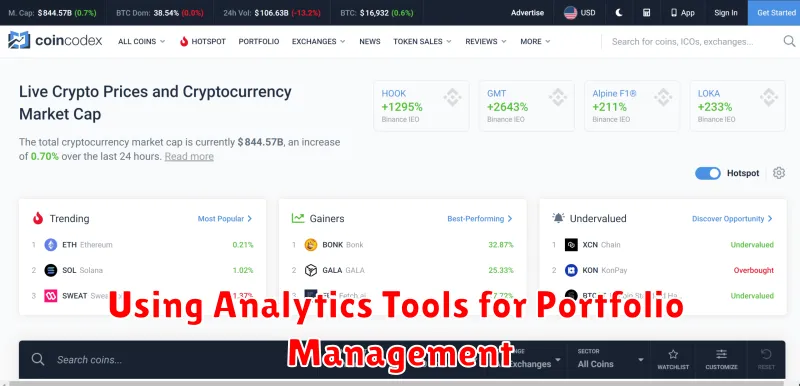Ready to level up your crypto game? This comprehensive guide, How to Diversify Your Crypto Portfolio Like a Pro, will teach you the secrets to building a robust and resilient portfolio. Learn expert strategies for cryptocurrency diversification, minimizing risk, and maximizing potential returns. Discover how to strategically allocate your assets across various cryptocurrencies, including Bitcoin, Ethereum, and beyond, to navigate the volatile crypto market effectively. We’ll cover everything from understanding market capitalization to identifying promising altcoins, helping you build a diversified portfolio that’s prepared for any market condition.
What is Crypto Portfolio Diversification?
Crypto portfolio diversification is the practice of spreading your investments across a range of different cryptocurrencies to reduce risk and potentially increase returns. Instead of putting all your eggs in one basket (e.g., only investing in Bitcoin), diversification involves investing in a variety of assets with different characteristics.
This strategy aims to minimize the impact of a single cryptocurrency’s poor performance on your overall portfolio. If one investment underperforms, the gains from others might offset the losses. The goal is to achieve a balanced portfolio that aligns with your risk tolerance and investment goals.
Diversification considers various factors such as market capitalization (the total value of a cryptocurrency), technology (underlying blockchain and its applications), and project maturity (how long the project has been active and its track record). By carefully selecting diverse assets, you can aim to achieve a more stable and resilient portfolio over the long term.
Remember that while diversification can help mitigate risk, it doesn’t guarantee profits. It’s crucial to conduct thorough research before investing in any cryptocurrency and understand the inherent risks involved in the volatile crypto market.
The Importance of Risk Management

In the volatile world of cryptocurrency, risk management is not just important—it’s crucial for survival. A diversified portfolio is only as strong as its risk mitigation strategy. Without a clear understanding and plan to manage risk, even the most cleverly diversified portfolio can suffer significant losses.
Diversification itself is a form of risk management, spreading your investment across various cryptocurrencies to reduce the impact of any single asset’s price fluctuations. However, this is not enough. You also need to consider factors like market cycles, project viability, and regulatory changes. Each of these presents unique risks that require proactive mitigation.
Effective risk management involves setting realistic goals, defining your risk tolerance, and actively monitoring your portfolio. It means understanding the inherent volatility of crypto and accepting that losses are possible. This knowledge should inform your investment decisions, guiding you toward a strategy that aligns with your comfort level and financial objectives.
Dollar-cost averaging, stop-loss orders, and regular portfolio reviews are practical risk management tools. These techniques allow for systematic investment, protection against significant losses, and adjustments based on changing market conditions. Remember that a well-defined risk management strategy is the cornerstone of long-term success in the cryptocurrency market.
Investing in Top Cryptocurrencies

Diversification is key in the volatile world of cryptocurrencies. While focusing on a few top cryptocurrencies offers potential for high returns, it also carries significant risk. A well-diversified portfolio mitigates this risk.
Consider investing in Bitcoin (BTC) and Ethereum (ETH), the two largest cryptocurrencies by market capitalization. These established coins offer relative stability compared to newer altcoins, though they are still subject to market fluctuations. They also often benefit from broader market trends.
Beyond Bitcoin and Ethereum, explore other blue-chip cryptocurrencies such as Solana (SOL), Cardano (ADA), and Binance Coin (BNB). Each offers unique features and technological advantages, providing further diversification. Thorough research into each cryptocurrency’s underlying technology and use case is crucial before investing.
Remember that the cryptocurrency market is highly speculative. Only invest what you can afford to lose. Don’t follow hype alone; base your investment decisions on careful analysis and risk tolerance. Consider consulting a financial advisor before making any investment decisions.
Regularly review your portfolio and adjust your holdings as needed. The cryptocurrency landscape is constantly evolving, so maintaining a dynamic investment strategy is vital for long-term success. Keep up-to-date with market trends and technological advancements to make informed choices.
Exploring Altcoins for Better Gains
Diversifying your crypto portfolio beyond Bitcoin and Ethereum can significantly boost your potential returns. Altcoins, or alternative cryptocurrencies, offer exposure to a wider range of technologies and market trends. While inherently riskier due to their often smaller market capitalization and volatility, strategic altcoin selection can lead to substantial gains.
Thorough research is paramount. Before investing in any altcoin, deeply investigate the project’s whitepaper, understand its underlying technology, and assess the team’s experience and reputation. Analyze the project’s utility, community engagement, and overall market sentiment. Look for projects with strong fundamentals and a clear path to adoption.
Consider diversification within altcoins. Don’t put all your eggs in one basket. Spread your investment across multiple altcoins with varying levels of risk and potential reward. Consider projects focusing on different sectors such as DeFi, NFTs, Metaverse, and Layer-2 scaling solutions. This approach mitigates risk and increases your chances of profiting from successful projects.
Manage risk effectively. Altcoins are known for their volatility. Implement proper risk management strategies, such as setting stop-loss orders and diversifying across multiple exchanges. Never invest more than you can afford to lose. Regularly review your portfolio and adjust your holdings based on market conditions and your investment goals.
Remember that past performance is not indicative of future results. The cryptocurrency market is highly dynamic, and altcoins can experience rapid price fluctuations. While the potential for higher returns exists, so does the risk of significant losses. Proceed with caution and always conduct your own due diligence.
Balancing Stablecoins in Your Portfolio

Stablecoins, pegged to fiat currencies like the US dollar, offer a crucial role in a diversified crypto portfolio. They provide stability and a safe haven during market volatility, acting as a buffer against significant losses in more volatile crypto assets. Think of them as your portfolio’s “cash” equivalent in the crypto world.
However, the key is balance. While stablecoins offer security, holding too many can hinder potential gains from the growth of other, more volatile cryptocurrencies. A completely stablecoin-heavy portfolio might miss out on significant returns. The ideal proportion depends on your risk tolerance and investment goals.
Consider your risk profile. A conservative investor might allocate a larger percentage to stablecoins (e.g., 50% or more), prioritizing capital preservation. A more aggressive investor, comfortable with higher risk, might allocate a smaller percentage (e.g., 10-20%), focusing more on the potential upside of other crypto investments.
Furthermore, it’s important to diversify your stablecoins themselves. Don’t put all your eggs in one basket. Explore different stablecoin options, considering their underlying collateral and mechanisms to ensure you’re not overly exposed to a single point of failure. Always research and understand the risks associated with each stablecoin before investing.
Ultimately, the best allocation for stablecoins is a personalized strategy. It’s a balancing act between minimizing risk and maximizing potential returns. Regularly review and adjust your portfolio allocation based on market conditions and your evolving risk tolerance.
Incorporating DeFi Tokens
Decentralized Finance (DeFi) tokens represent a significant opportunity for portfolio diversification. These tokens often power platforms offering innovative financial services like lending, borrowing, and yield farming, providing exposure to a rapidly growing sector.
Due diligence is crucial. Thoroughly research individual projects, examining their whitepapers, team expertise, and community engagement. Pay close attention to the token’s utility within the DeFi ecosystem – understanding its role is paramount.
Risk management is key. The DeFi space is inherently volatile. Diversify your DeFi holdings across multiple projects and protocols to mitigate the risk of a single project failing. Consider the smart contract audits of the protocols you invest in, as vulnerabilities can lead to significant losses.
Start small. Allocate a percentage of your portfolio to DeFi tokens that aligns with your risk tolerance. Avoid investing more than you can afford to lose. Gradual diversification allows you to learn and adapt your strategy as the market evolves.
Stay informed. The DeFi landscape is constantly changing. Keep abreast of market trends, regulatory developments, and technological advancements to make informed decisions and adjust your portfolio accordingly.
By carefully incorporating DeFi tokens into your strategy, you can potentially enhance returns and diversify away from traditional cryptocurrencies. Remember, this is a high-risk, high-reward sector requiring significant research and a thoughtful approach.
Using Analytics Tools for Portfolio Management

Effective crypto portfolio management relies heavily on leveraging analytics tools. These tools provide crucial data-driven insights, allowing you to make informed decisions and optimize your strategy. Real-time market data is essential for understanding price fluctuations and market trends. Tools displaying historical performance of different cryptocurrencies help in identifying patterns and assessing risk.
Many platforms offer portfolio tracking features, automatically calculating your overall portfolio value, allocation across different assets, and profit/loss. This allows for easy monitoring of your investment performance. Advanced tools may also provide risk assessments, diversification scores, and even suggest rebalancing strategies based on your risk tolerance and investment goals.
Beyond simple tracking, analytics tools can help you identify potential investment opportunities through technical analysis charts, showing indicators like moving averages and relative strength index (RSI). They can also provide warnings of potential risks, flagging assets that show signs of high volatility or market manipulation. By using these tools proactively, you can improve your ability to react to market changes and make better-informed investment choices.
Choosing the right analytics tool depends on your experience level and specific needs. Some offer free, basic features while others provide in-depth analysis for a subscription fee. Consider factors like ease of use, data accuracy, and the range of features offered when selecting a tool. Ultimately, data-driven decision making is key to successful and diversified crypto portfolio management.
Adjusting Your Portfolio Over Time
The cryptocurrency market is incredibly dynamic. What works today might not work tomorrow. Therefore, regularly adjusting your portfolio is crucial for long-term success. This isn’t about constant frantic trading, but rather a strategic approach to maintaining a diversified and healthy portfolio.
Regular Reviews: Aim to review your portfolio at least quarterly, or even monthly if you’re more actively involved. This allows you to assess the performance of your individual holdings and the overall market trends.
Market Analysis: Stay informed about market trends and news. Understanding the factors affecting the prices of your cryptocurrencies will help you make informed decisions. Look at adoption rates, regulatory changes, and technological advancements for a comprehensive view.
Rebalancing: As certain cryptocurrencies outperform others, your portfolio might drift from your initial allocation. Rebalancing involves selling some of your overperforming assets and reinvesting in underperforming or new promising ones to maintain your desired asset allocation.
Risk Tolerance: Your risk tolerance plays a vital role. A younger investor might be more comfortable with higher-risk, higher-reward investments, whereas an older investor might prefer a more conservative approach. Adjust your portfolio accordingly as your circumstances or risk tolerance change.
Diversification is Key: Remember, diversification is not a one-time event. Continuously monitor and adjust your holdings to ensure that your portfolio remains appropriately diversified across different cryptocurrencies and asset classes.
Tax Implications: Be mindful of the tax implications of buying, selling, and trading cryptocurrencies. Consult with a financial advisor if needed to understand the tax rules in your region and plan accordingly. Capital gains taxes can significantly impact your returns.
Adjusting your crypto portfolio over time is an ongoing process. By staying informed, analyzing the market, and regularly rebalancing your holdings, you can significantly improve your chances of achieving your long-term financial goals.
Avoiding Common Diversification Mistakes
Diversifying your crypto portfolio is crucial for mitigating risk, but many investors make costly mistakes. One common error is over-diversification. While spreading your investments across multiple assets is good, holding too many coins can make it difficult to track performance and potentially dilute your returns.
Another pitfall is under-diversification. Focusing solely on a few “hot” coins, despite their potential, exposes you to significant risk if those projects underperform. A balanced portfolio across various market caps and sectors is key.
Ignoring market capitalization is another frequent mistake. While smaller-cap coins can offer higher potential returns, they’re also significantly riskier. A well-diversified portfolio typically includes a mix of large, mid, and small-cap cryptocurrencies, balancing potential gains with risk tolerance.
Many investors also neglect asset class diversification. Crypto isn’t a monolithic asset; it encompasses various types like Bitcoin, altcoins, stablecoins, and DeFi tokens. A truly diversified portfolio considers these differences.
Finally, emotional investing can severely hinder diversification efforts. Fear and greed can lead to impulsive decisions, disrupting a well-planned strategy. Sticking to your predetermined allocation strategy, even during market volatility, is essential.
By avoiding these common mistakes, you can build a robust and diversified crypto portfolio that aligns with your risk tolerance and investment goals. Remember, diversification is a journey, not a destination; regular review and adjustments are critical.

